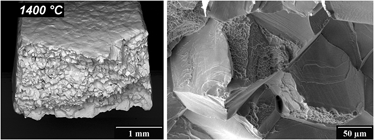Crossref Citations
This article has been cited by the following publications. This list is generated based on data provided by
Crossref.
Málek, Jaroslav
Zýka, Jiří
Lukáč, František
Vilémová, Monika
Vlasák, Tomáš
Čížek, Jakub
Melikhova, Oksana
Macháčková, Adéla
and
Kim, Hyoung-Seop
2019.
The Effect of Processing Route on Properties of HfNbTaTiZr High Entropy Alloy.
Materials,
Vol. 12,
Issue. 23,
p.
4022.
Málek, Jaroslav
Zýka, Jiří
Lukáč, František
Čížek, Jakub
Kunčická, Lenka
and
Kocich, Radim
2019.
Microstructure and Mechanical Properties of Sintered and Heat-Treated HfNbTaTiZr High Entropy Alloy.
Metals,
Vol. 9,
Issue. 12,
p.
1324.
Laplanche, G.
Gadaud, P.
Perrière, L.
Guillot, I.
and
Couzinié, J.P.
2019.
Temperature dependence of elastic moduli in a refractory HfNbTaTiZr high-entropy alloy.
Journal of Alloys and Compounds,
Vol. 799,
Issue. ,
p.
538.
Lukac, Frantisek
Musalek, Radek
Vilemova, Monika
Cizek, Jakub
Kuriplach, Jan
Straska, Jitka
Zyka, Jiri
and
Malek, Jaroslav
2019.
Defects in the high entropy alloy HfNbTaTiZr prepared by spark plasma sintering.
Vol. 2202,
Issue. ,
p.
050013.
Zýka, Jiří
Málek, Jaroslav
Veselý, Jaroslav
Lukáč, František
Čížek, Jakub
Kuriplach, Jan
and
Melikhova, Oksana
2019.
Microstructure and Room Temperature Mechanical Properties of Different 3 and 4 Element Medium Entropy Alloys from HfNbTaTiZr System.
Entropy,
Vol. 21,
Issue. 2,
p.
114.
Park, Ki Beom
Park, Jae-Young
Kim, Young Do
Na, Tae-Wook
Mo, Chan Bin
Choi, Jong-In
Choi, Jun
Kang, Hyun-Su
and
Park, Hyung-Ki
2021.
Spark plasma sintering behavior of TaNbHfZrTi high-entropy alloy powder synthesized by hydrogenation-dehydrogenation reaction.
Intermetallics,
Vol. 130,
Issue. ,
p.
107077.
Akmal, Muhammad
Park, Hyung-Ki
and
Ryu, Ho Jin
2021.
Plasma spheroidized MoNbTaTiZr high entropy alloy showing improved plasticity.
Materials Chemistry and Physics,
Vol. 273,
Issue. ,
p.
125060.
Wu, Yaqi
Liaw, Peter
and
Zhang, Yong
2021.
Preparation of Bulk TiZrNbMoV and NbTiAlTaV High-Entropy Alloys by Powder Sintering.
Metals,
Vol. 11,
Issue. 11,
p.
1748.
Hruška, Petr
Lukáč, František
Cichoň, Stanislav
Vondráček, Martin
Čížek, Jakub
Fekete, Ladislav
Lančok, Ján
Veselý, Jozef
Minárik, Peter
Cieslar, Miroslav
Melikhova, Oksana
Kmječ, Tomáš
Liedke, Maciej Oskar
Butterling, Maik
and
Wagner, Andreas
2021.
Oxidation of amorphous HfNbTaTiZr high entropy alloy thin films prepared by DC magnetron sputtering.
Journal of Alloys and Compounds,
Vol. 869,
Issue. ,
p.
157978.
Lukáč, František
Vilémová, Monika
Klementová, Mariana
Minárik, Peter
and
Chráska, Tomáš
2021.
The origin and the effect of the fcc phase in sintered HfNbTaTiZr.
Materials Letters,
Vol. 286,
Issue. ,
p.
129224.
Razumov, N. G.
Makhmutov, T. Yu.
Kim, A.
Goncharov, I. S.
Ozerskoi, N. E.
Silin, A. O.
Mazeeva, A. K.
and
Popovich, A. A.
2021.
Structure and Properties of a High-Entropy Ti-Zr-Hf-Ni-Co-Cu Alloy Obtained by Mechanical Alloying and Spark Plasma Sintering.
Metallography, Microstructure, and Analysis,
Vol. 10,
Issue. 4,
p.
474.
Kozlík, Jiří
Preisler, Dalibor
Stráský, Josef
Košutová, Tereza
Corrêa, Cinthia Antunes
Veselý, Jozef
Bodnárová, Lucie
Lukáč, František
Chráska, Tomáš
and
Janeček, Miloš
2022.
Manufacturing of biomedical Ti alloys with controlled oxygen content by blended elemental powder metallurgy.
Journal of Alloys and Compounds,
Vol. 905,
Issue. ,
p.
164259.
Wang, H.
Niu, Zhiyuan
Chen, Cunguang
Chen, Haiqun
Zhu, Xingying
Zhou, Fa
Zhang, Xiaobin
Jiang, Suihe
Liu, Xiongjun
and
Wu, Yuan
2022.
Powder Production of an Equimolar Nbtatizr High-Entropy Alloy Via Hydrogen Embrittlement.
SSRN Electronic Journal ,
Wang, Hui
Niu, Zhiyuan
Chen, Cunguang
Chen, Haiqun
Zhu, Xingying
Zhou, Fa
Zhang, Xiaobin
Liu, Xiongjun
Wu, Yuan
and
Jiang, Suihe
2022.
Powder production of an equimolar NbTaTiZr high-entropy alloy via hydrogen embrittlement.
Materials Characterization,
Vol. 193,
Issue. ,
p.
112265.
Li, Xiaofeng
Fu, Ao
Cao, Yuankui
Xu, Shenghang
and
Gao, Shenghan
2022.
High-temperature mechanical properties and deformation behavior of carbides reinforced TiNbTaZrHf composite.
Journal of Alloys and Compounds,
Vol. 894,
Issue. ,
p.
162414.
Liu, Che-Jen
Gadelmeier, Christian
Lu, Shao-Lun
Yeh, Jien-Wei
Yen, Hung-Wei
Gorsse, Stéphane
Glatzel, Uwe
and
Yeh, An-Chou
2022.
Tensile creep behavior of HfNbTaTiZr refractory high entropy alloy at elevated temperatures.
Acta Materialia,
Vol. 237,
Issue. ,
p.
118188.
Noble, Niveditha
Radhika, N.
Sathishkumar, M.
and
Saleh, Bassiouny
2023.
Characterisation and property evaluation of High Entropy Alloy coating on 316L steel via thermal spray synthesis.
Tribology International,
Vol. 185,
Issue. ,
p.
108525.
Chen, Li
Li, Zhanjiang
Dai, Pinqiang
Fu, Peixin
Tang, Qunhua
and
Chen, Junfeng
2023.
Microstructure and tensile properties of metastable Fe50Mn30Co10Cr10 high-entropy alloy prepared via powder metallurgy.
Journal of Alloys and Compounds,
Vol. 955,
Issue. ,
p.
170225.
Potnis, Gaurav
Goswami, Debottam
and
Das, Jayanta
2023.
Twinning mediated plasticity in high entropy CoCr1.3FeNi0.7MnNb (x = 0.3, 0.367, 0.4) ultrafine lamellar eutectic by tuning stacking fault energy.
Scripta Materialia,
Vol. 227,
Issue. ,
p.
115271.
Chen, Yubing
Liu, Peidong
Dong, Zhaowang
Liu, Hanning
Wang, Junjie
Guo, Xueyi
Xia, Yang
and
Wang, Qinmeng
2023.
Sintering, Microstructure, and Mechanical Properties of TiTaNbZrHf High-Entropy Alloys Prepared by Cold Isostatic Pressing and Pressure-Less Sintering of Hydrides.
Materials,
Vol. 16,
Issue. 5,
p.
1759.



